Written by Brian Kabaluk
The Kabaluk families settled in Landerville around 1910. Most of the early settlers in the Lac du Bonnet area found it difficult to earn a living farming and there was very little other work available so their income had to be supplemented by cutting pulp wood. My dad, Nick Kabaluk and his brother Alex kept a record of their income from cutting pulp wood from 1935 to 1940. In 1935 my dad was 20 years old while his brother Alex was only 15. That year they cut 117 cords at $1.25 a cord earning $146.25 for the entire winter. The wood had to be cut by hand, into 4' lengths and hauled out with a team of horses and sled to the nearest railroad then loaded on the rail cars. Due to the lack of roads where they cut the wood, the work could only be done in winter when the horses were able to pull a sled.
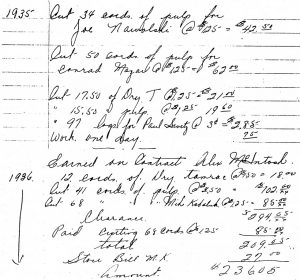
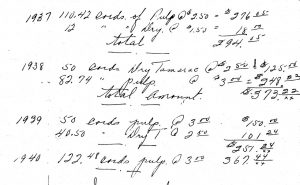
As difficult as the wood cutting was with poor tools and clothing in such extreme weather conditions, maintaining a farm was equally as difficult because everything had to be done by hand. One example of such work is a building that is still standing on our old farm on the corner of Hanson Road and #11 highway. This building was built in Landerville by my dad and his brother Alex as a pig barn over 80 years ago. All the logs were squared with an ax and the dovetailed corners cut with a hand saw. With the primitive tools that they had, the craftsmanship was quite remarkable. The corner joints are almost as tight today as they were when it was build. In 1945 my dad hauled that barn from Landerville on skids with a tractor to our new farm two miles south of Lac du Bonnet.
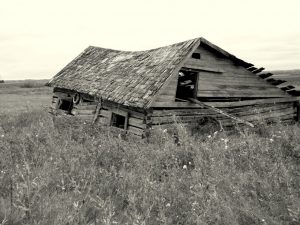
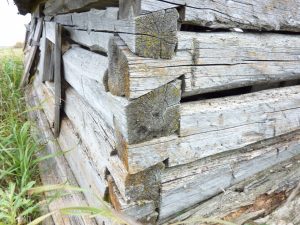
There were two Kabaluk families who originally settled in Landerville. My grandfather Stanley Kabaluk and his brother John. Stanley had three sons Micheal, Alex and my dad Nick.
John had four sons and one daughter, they were Bill, Mike, Pete, Dan and Kate. Kate owned the Wal-Bec theater. Her former husband was Walter Becta.
My grandfather also had a sister Mary who was married to Andrew Olynick. They also lived in Landerville and had a large family, John, Mike, Ann (Haladki/Bracnick), Katie (Mazur), Dora (Lesko/Giffth), Nellie (Gurniak/?) Peter, Josie (Kohanoski), and Mary (Haladki). Through this family I'm related to half of Lac du Bonnet.
My grandfather also had another brother, John, who lived in Brokenhead. The reason that there were two Johns in that family was because that was the way their two different Ukrainian names were translated into English when they immigrated to Canada.
The Kabaluk who owned the store by the school was Bill. When he sold that store he bought a chip stand/pool room next to Casey's Inn. I believe that his brother Mike also owned a store in Landerville for a while. Gordon Kabaluk might know. His dad was Pete.

In 1950, we moved into a house next to Central Northern Airlines just above the town dock. Lac du Bonnet was vibrant and alive with people everywhere, especially on weekends when all the farming communities would converge on the town to shop and socialize. Part of the ambiance of the town was the sound of gospel music on the sidewalks and the smell of french fries and vinegar, while crowds gathered around the two chips stands and construction workers, miners and rice pickers packed the two beer parlors.
I'm thankful to have had the privilege of growing up in a very unique environment at such an exciting time and fortunate for not having television, video games or cell phones because we used our imaginations. Most of the the toys and games that we had, we made ourselves. One day we could be pirates with a stick for a sword, while the next day that same stick could be a gun.
One game that we often played was “knock out ginger”, where we would knock on a door, then just before the occupant would open it we would run like hell. Some people would actually chase us, but little did they know that if they just ignored us we wouldn't knock on their door again.
On Halloween we took trick or treating to another level by tipping over outdoor toilets. One individual was targeted more than others because he would put rotten fruit and vegetables from his store in our bags. We waited patently in the lane until he came out to use his toilet. Once comfortably inside and resting on his throne, we tipped the toilet over onto the door, trapping him inside. I'm sure that many people breathed a huge collective sigh of relief when the town announced the new sewage system and the end of outdoor toilets.
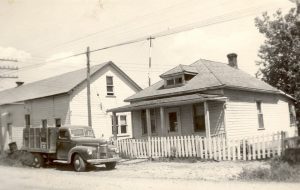 After our house was remodeled with our bedroom facing the street, my brother and I had a front row seat of live fights out of our bedroom window as the bar room brawls tumbled out into the street from the beer parlor of the Lakeview Hotel.
After our house was remodeled with our bedroom facing the street, my brother and I had a front row seat of live fights out of our bedroom window as the bar room brawls tumbled out into the street from the beer parlor of the Lakeview Hotel.
The town dock at our back door was the center of activity, winter and summer, with tobogganing, skating, fishing and swimming as well as numerous other sports around town. There was never a shortage of activities. I don't ever remember any kids whining about being bored. “Bored” was simply not in our vocabulary. We could walk for miles in either direction along the river from Pickerel Rock to Holiday Beach. Even with the school just across the street, at times it was just too tempting to skip classes and go fishing.
Growing up in LDB wasn't all play. Many of us had newspaper routes where we lugged huge bags of papers around town every evening. One of the most memorable jobs was working for one of our teachers, Mr. Zaborniak. While he drove a tractor and stone bolt on his farm in Brightstone, we picked rocks in pails. At the end of a back breaking day we got paid a penny a pail.
Our living room window looked right into the CNA and later Trans Air office where many of the legendary bush pilots partied and played cards long into the night. But the planes were always flying at daybreak, transporting passengers, freight and mail to outposts throughout northern Manitoba, Ontario and the NWT. Unfortunately some never returned. In the early fifties many adults were still in awe of these incredible flying machines, but for a wide eyed kid from the farm they were an unimaginable sight. One day while I was poking around on the dock, George Fournier, the head mechanic, invited me up for a ride in a Norseman. My heart almost thumped out of my chest with excitement. When we leveled off he asked me to hold the stick and not touch anything else. With a wrench in one hand, he opened the door and crawled out onto the wing strut. Hanging on with one arm and one leg he adjusted a cable on the flap while I sat there frozen, unable to move or breath. There were still a few older airplanes flying out of CNA like the Waco, Tiger Moth, Norseman and the largest single engine plane the Bellanca. Within a short time the Beaver arrived. Because of its design and powerful engine it could get off the water quicker, allowing it to get into small lakes that were not accessible with other air crafts. Every time I hear the drone of the unmistakable and unforgettable Pratt & Whitney radial engine of a Beaver flying overhead it takes me back across the country to the banks of the Winnipeg River.
At that time the Community Hall, Lagsdin's Hall, Holiday Beach and Riverland Hall were all booming on weekends with social events, as well as numerous house parties. Today the dance halls are gone and the bars are empty, seemingly replaced by a personal care home, medical clinic, wellness centers physiotherapy clinics. It almost seems like the town has evolved with the generation that I grew up with. The times have changed, as have the demographics of the town, with many new homes and businesses and a quieter laid back lifestyle, it still appears to be a great place to grow up.